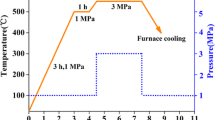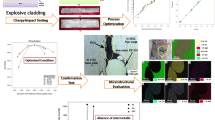Abstract
This research was undertaken to produce strong and stiff, aluminum-titanium, multi-layered composites (laminates) by explosive welding, for applications requiring light-weight. The purpose of lamination is to create a material with superior mechanical properties resulting from plastic deformation produced by shock wave passage throughout each layer and from the presence of the explosively welded interfaces. A response surface study was performed on these laminates to investigate the mechanical behavior of the laminates with changes in two characteristic variables, abundance of interfaces and volume percentage of the more ductile component. For this purpose, a total of eighteen laminates, nine of which were the basis of a central composite design, were produced. One-step welding of these laminates was achieved by explosives-introduced pressuring; the material was supported by thicker steel plates on both sides to reduce the harmful effects of detonation and to produce smooth top and bottom surfaces. Yield strength, ultimate tensile strength, and elongation data were collected from tensile tests. A second-order model was fitted and a three dimensional response surface was built to define the relationship among the mechanical properties (yield strength) of the laminates and two design variables. The fitted second-order model clearly shows that the mechanical properties of the laminates depend strongly on the relative amounts of the components but only weakly on the abundance of interfaces within the selected operability region.
Similar content being viewed by others

References
D. Tench and J. White, Metallurgical Trans. 15A (1984) 2039–2056.
S. L. Lehoczky, J. Appl. Phys. 49 (1978) 5479–5485.
U. Helmersson, S. Todorova, S. A. Barnett and J-E. Sundgren, ibid. 62 (1987) 481–484.
C. A. Hoffman and J. W. Weeton, Metallurgical Trans. 5 (1974) 309–315.
D. Baral, J. B. Ketterson and J. E. Hilliard, J. Appl. Phys. 57 (1985) 1076–1083.
B. S. Berry and W. C. Pritchet, Thin Solid Films 33 (1976) 19–28.
D. P. Adams, M. Vill, J. Tao, J. C. Billelo and S. M. Yalisove, J. Appl. Phys. 74(2) (1993) 1015–1021.
C. Sarrazin, J. P. RiviÈre and R. J. Gaboriaud, Physica Status Solidi, Applied Research, A 107 (1988) 867–871.
S. A. L. Salem and S. T. S. Al-hassani, in “Shock Waves and High Strain Rate Phenomena in Metals,” edited by M. A. Meyers and L. E. Murr (Plenum Press, New York) pp. 1003–1018.
S. N. Shoukry and A. A. Hegazy, Propellants, Explosives, Pyrotechnics 13 (1988) 144–148.
K. Hokamoto, A. Chiba and M. Fujita, Compos. Eng. 5(8) (1995) 1069–1079.
M. M. Schwartz,“Metals Joining Manual” (McGraw-Hill Book Company, USA, 1979) Section 5.
R. H. Myers and D. C. Montgomery, “Response Surface Methodology,” (John Wiley & Sons, USA, 1995).
B. F. Ryan and B. L. Joiner, “Minitab Handbook” (Duxbury Press, Belmont, CA, 1994).
“Metals Handbook,” Vol. 2, (ASM International, USA, 1990) p. 62.
“Metals Handbook,” Vol. 2, (ASM International, USA, 1990) p. 592.
Author information
Authors and Affiliations
Rights and permissions
About this article
Cite this article
Ege, E.S., Inal, O.T. & Zimmerly, C.A. Response surface study on production of explosively-welded aluminum-titanium laminates. Journal of Materials Science 33, 5327–5338 (1998). https://doi.org/10.1023/A:1004485914302
Issue Date:
DOI: https://doi.org/10.1023/A:1004485914302



